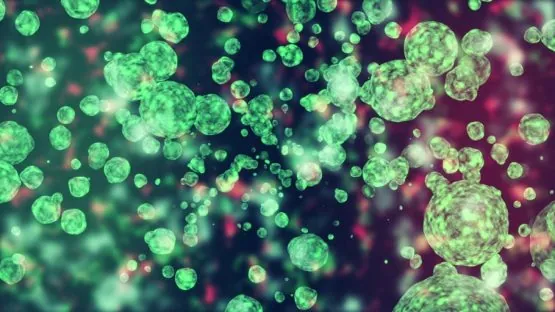Cytomegalovirus (CMV) is a β-herpesvirus that infects the majority of people in the world. It lies dormant in the body, waiting for an opportunity to strike when the immune system is weakened. This persistent virus infects people for their entire lives, and now researchers have discovered how the virus spreads, opening the door to ways to destroy it.
What is cytomegalovirus?
CMV is part of the β-subfamily of herpesviruses, which are believed to have been co-evolving with their hosts for around 180 million years [1]. CMV infection is asymptomatic; this means it causes no symptoms and is a latent infection; in other words, it lies dormant in the cell, awaiting activation under certain conditions [2].
It is thought that CMV periodically reactivates and attempts to spread, so in order to prevent this, the immune system must keep infected cells under constant, lifelong immune surveillance in order to keep it under control. In this way, it has been proposed that CMV and other similar persistent viruses contribute to infectious burden and aging, as our dwindling supplies of immune cells are increasingly tied up in keeping it under control. Indeed, patients who have compromised immune systems are at greater risk for CMV reactivation, which can lead to an increase of morbidity and mortality [3].
CMV is a highly successful virus that has managed to infect most humans on the planet. This is because CMV is spread readily via exposure to infected secretions and subsequent mucosal contact, which then goes on to infect multiple cell types in the body. After this initial infection, the virus spreads and then enters a dormant (latent) period.
In order to reactivate and awaken from this dormant state, CMV, like all herpesviruses, progresses through an ordered cascade that starts with the expression of intermediate-early genes, which serve as a trigger for further (early and late) viral gene expression [4]. Studies show that CMV periodically expresses these intermediate-early genes at random during its dormant period, meaning that there is a constant background level of CMV reactivation [5-6].
Once these initial genes are expressed, the cycle moves onto expressing genes for host manipulation, DNA replication, and viral packaging. The expression of the intermediate-early genes is closely linked to proinflammatory transcription factors, including NF-κB, TNFα and interleukin-1β. These proinflammatory signals can then reactivate CMV as a result of this association [7-8].
In this way, CMV reacts to its environment, and its activity is largely regulated by the presence of localized inflammation. This means that injuries and other sources of inflammation, such as those that are part of the aging processes, might reactivate CMV from dormancy and help it spread. Also, as we age and our immune systems decline, this leaves us with fewer immune cells to maintain surveillance on infected cells, which further facilitates its spread.
A new way to target CMV
A research team led by Dr. Leor S. Weinberger, William and Ute Bowes Distinguished Professor and director of the Gladstone–UCSF Center for Cell Circuitry, has discovered how the CMV virus replicates [9]. The study was recently published in the journal PNAS, and it opens the door for therapies that could target the persistent virus and remove it from the body.
Under normal circumstances, when a virus invades the cell, the cell responds by inhibiting the viral DNA and preventing it from working. In order to succeed, the virus must somehow compromise this defense system. CMV, it turns out, does exactly that and, thanks to this new study, we now know how it bypasses our cellular defenses. CMV invades the cell, carrying its viral DNA with it, but it also takes with it PP71 proteins, which it then uses to replicate and spread the virus to more healthy cells.
Interestingly, the PP71 proteins that the virus uses to replicate and spread only last a few hours before they break apart, so the researchers questioned how the virus could spread when the PP71 was gone. The answer was that while the PP71 is in the cell, it interacts with another protein called IE1, which occurs not long after the virus invades the cell. Once PP71 is gone, the IE1 facilitates the creation of new viruses, allowing it to spread.
During the study, the research team developed a synthetic version of the virus that allowed them to calibrate the amount of IE1 protein. This allowed them to observe the virus invading cells while controlling the amount of IE1 protein available and how long it lasted. They observed that when IE1 is present at normal levels and it degrades slowly, the virus has plenty of time to replicate and spread to other cells.
Conclusion
This confirms that CMV requires the presence of the IE1 protein and for it to be around for a long-enough period for the virus to use it to replicate. Therefore, IE1 is an attractive target for therapies aimed at destroying CMV and other related herpesviruses, such as Epstein-Barr, and herpes simplex virus type 1 and 2, which cause most cold sores and genital herpes.
The effects of CMV infection on the immune system and its role in aging may be quite significant, given how common and widespread it is in the human population; therefore, understanding how this virus is able to replicate is an important development in finding ways to remove it from the body. Therapies that target IE1 could effectively shut down CMV and potentially allow us to eradicate it forever.
Literature
[1] McGeoch, D. J., Cook, S., Dolan, A., Jamieson, F. E., & Telford, E. A. (1995). Molecular phylogeny and evolutionary timescale for the family of mammalian herpesviruses. Journal of molecular biology, 247(3), 443-458.
[2] Fields, B. N., Knipe, D. M., Howley, P. M., & Griffin, D. E. (2007). Fields virology. 5th.
[3] Crough, T., & Khanna, R. (2009). Immunobiology of human cytomegalovirus: from bench to bedside. Clinical microbiology reviews, 22(1), 76-98.
[4] Hermiston, T. W., Malone, C. L., Witte, P. R., & Stinski, M. F. (1987). Identification and characterization of the human cytomegalovirus immediate-early region 2 gene that stimulates gene expression from an inducible promoter. Journal of Virology, 61(10), 3214-3221.
[5] Grzimek, N. K., Dreis, D., Schmalz, S., & Reddehase, M. J. (2001). Random, Asynchronous, and Asymmetric Transcriptional Activity of Enhancer-Flanking Major Immediate-Early Genes ie1/3 andie2 during Murine Cytomegalovirus Latency in the Lungs. Journal of Virology, 75(6), 2692-2705.
[6] Henry, S. C., & Hamilton, J. D. (1993). Detection of murine cytomegalovirus immediate early 1 transcripts in the spleens of latently infected mice. Journal of Infectious Diseases, 167(4), 950-954.
[7] Hummel, M., Zhang, Z., Yan, S., DePlaen, I., Golia, P., Varghese, T., … & Abecassis, M. I. (2001). Allogeneic transplantation induces expression of cytomegalovirus immediate-early genes in vivo: a model for reactivation from latency. Journal of Virology, 75(10), 4814-4822.
[8] Cook, C. H., Trgovcich, J., Zimmerman, P. D., Zhang, Y., & Sedmak, D. D. (2006). Lipopolysaccharide, tumor necrosis factor alpha, or interleukin-1β triggers reactivation of latent cytomegalovirus in immunocompetent mice. Journal of virology, 80(18), 9151-9158.
[9] Vardi, N., Chaturvedi, S., & Weinberger, L. S. (2018). Feedback-mediated signal conversion promotes viral fitness. Proceedings of the National Academy of Sciences, 115(37), E8803-E8810.



